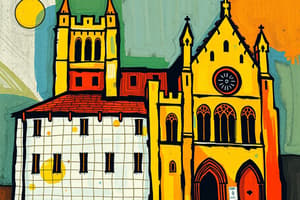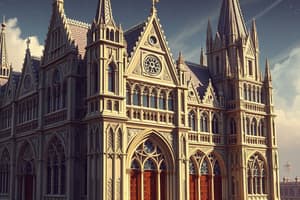Podcast
Questions and Answers
Scholars began to use ______ letters instead of capital letters, as the Romans did.
Scholars began to use ______ letters instead of capital letters, as the Romans did.
lowercase
Most students in Church schools were sons of ______ studying for careers in the clergy.
Most students in Church schools were sons of ______ studying for careers in the clergy.
nobles
In the 1200s, ______ schools gave rise to universities.
In the 1200s, ______ schools gave rise to universities.
cathedral
Ancient writers taught that ______ was the path to knowledge.
Ancient writers taught that ______ was the path to knowledge.
Thomas Aquinas tried to bridge the gap between ______ and reason.
Thomas Aquinas tried to bridge the gap between ______ and reason.
Natural law could be discovered through ______ alone.
Natural law could be discovered through ______ alone.
Medieval Europeans enjoyed festivals and fairs that marked important ______ of the year.
Medieval Europeans enjoyed festivals and fairs that marked important ______ of the year.
Christmas is celebrated as the day of the ______ of Jesus.
Christmas is celebrated as the day of the ______ of Jesus.
Easter celebrates the ______ of Christ.
Easter celebrates the ______ of Christ.
Plays often acted out Bible stories during ______ services on special days.
Plays often acted out Bible stories during ______ services on special days.
During the Middle Ages, most art was created for a ______ purpose.
During the Middle Ages, most art was created for a ______ purpose.
Most cathedrals were built in the shape of a ______.
Most cathedrals were built in the shape of a ______.
Cathedrals constructed between 1150 and 1400 were designed in the ______ style.
Cathedrals constructed between 1150 and 1400 were designed in the ______ style.
The word cathedral comes from the Latin word 'cathedra', meaning 'the ______ upon which a bishop sits.'
The word cathedral comes from the Latin word 'cathedra', meaning 'the ______ upon which a bishop sits.'
Gargoyles are decorative stone sculptures projecting from the rain ______ of a cathedral roof.
Gargoyles are decorative stone sculptures projecting from the rain ______ of a cathedral roof.
Beautiful stained-glass windows let in ______ light.
Beautiful stained-glass windows let in ______ light.
During the Middle Ages, most schooling took place in monasteries, convents, and ______.
During the Middle Ages, most schooling took place in monasteries, convents, and ______.
It took an average of ______ to ______ years to complete a cathedral.
It took an average of ______ to ______ years to complete a cathedral.
Some people believed gargoyles were placed as a reminder that ______ and evil spirits would catch them if they did not obey the Church's teachings.
Some people believed gargoyles were placed as a reminder that ______ and evil spirits would catch them if they did not obey the Church's teachings.
Charlemagne encouraged the Church to teach people to read and ______.
Charlemagne encouraged the Church to teach people to read and ______.
Flashcards
Medieval Art Purpose
Medieval Art Purpose
Medieval art primarily focused on religious themes, portraying Jesus and saints for worship in churches.
Cathedrals
Cathedrals
Large churches headed by bishops, typically built in a cross shape with a nave and transepts.
Gothic Style Cathedrals
Gothic Style Cathedrals
Cathedrals built between 1150-1400, designed to appear soaring towards heaven, with flying buttresses and stained glass windows.
Flying Buttresses
Flying Buttresses
Signup and view all the flashcards
Gargoyles
Gargoyles
Signup and view all the flashcards
Medieval Stained Glass Windows
Medieval Stained Glass Windows
Signup and view all the flashcards
Medieval Education Location
Medieval Education Location
Signup and view all the flashcards
Charlemagne's Educational Influence
Charlemagne's Educational Influence
Signup and view all the flashcards
Medieval Education
Medieval Education
Signup and view all the flashcards
Universities (1200s)
Universities (1200s)
Signup and view all the flashcards
Ancient Texts
Ancient Texts
Signup and view all the flashcards
Thomas Aquinas
Thomas Aquinas
Signup and view all the flashcards
Natural Law
Natural Law
Signup and view all the flashcards
Medieval Holidays
Medieval Holidays
Signup and view all the flashcards
Christmas Celebrations
Christmas Celebrations
Signup and view all the flashcards
Easter Celebrations
Easter Celebrations
Signup and view all the flashcards
Medieval Entertainment
Medieval Entertainment
Signup and view all the flashcards
Church Plays
Church Plays
Signup and view all the flashcards
Study Notes
Medieval Art and Architecture
- Primarily religious in purpose, depicting Jesus and saints for worship
- Cathedrals (large churches led by bishops) were central, built to inspire awe (often taller than 30-story modern buildings)
- Cross-shaped, with a nave (long central section) and transepts (shorter side sections)
- Gothic style (1150-1400) designed to seem heavenly
- Flying buttresses (stone arches) supported the roof and walls, enabling taller, thinner walls, and more windows
- Gargoyles (decorative stone sculptures) projected from roofs, often mythical beasts. Some believed to ward off evil spirits
- Interior: Pillars, religious images, colorful stained-glass depicting Biblical scenes
- Hundreds of workers and craftsmen, took 50-100 years (sometimes over 200) to construct
Medieval Education
- Focused mainly in monasteries, convents, and cathedrals
- Charlemagne fostered reading/writing in the Church
- New writing system using lowercase letters developed by scholars simplified reading
- Clergy were the most educated
- Students (mostly nobleman's sons) studied for clergy careers, memorizing prayers and Biblical Latin passages
- Cathedral schools evolved into universities by 1200s
- Univ. studies: Latin grammar, rhetoric, logic, geometry, arithmetic, astronomy, music
- Books rare, so teachers read aloud from them
- Ancient texts respected, but Church initially cautious due to differing views on knowledge acquisition, with faith versus reason
- Thomas Aquinas bridged the gap, admiring Aristotle and seeing no conflict between reason and faith (natural law derived from God's creation)
- Aquinas promoted a synthesis of philosophy and theology
Medieval Holidays
-
Many festivals and celebrations tied to the church (holy days)
-
Key holidays: Christmas (12-day celebration, church attendance, feasts) and Easter (Resurrection celebration with services, feasting, games; eggs as a symbol of new life)
-
Entertainment included music, dancing, food, bonfires, acrobats, jugglers, dancing bears, plays (Bible stories acted out in religious services, by the 13th century held outdoors, and English village mummers)
Studying That Suits You
Use AI to generate personalized quizzes and flashcards to suit your learning preferences.




